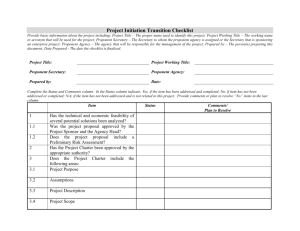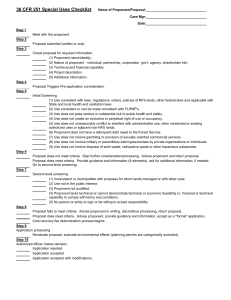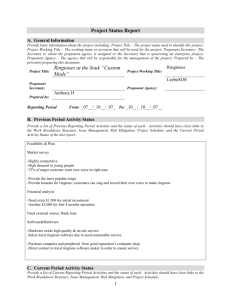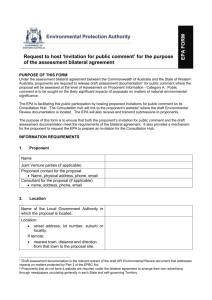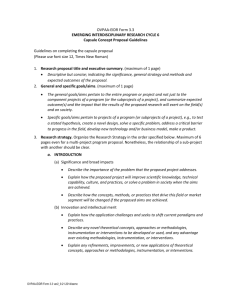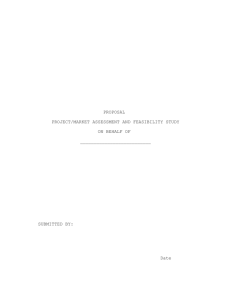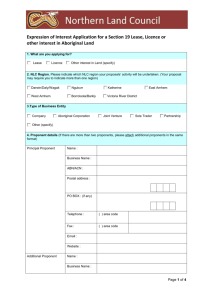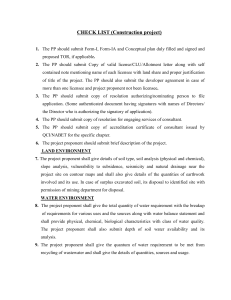Project Analysis Worksheet
advertisement
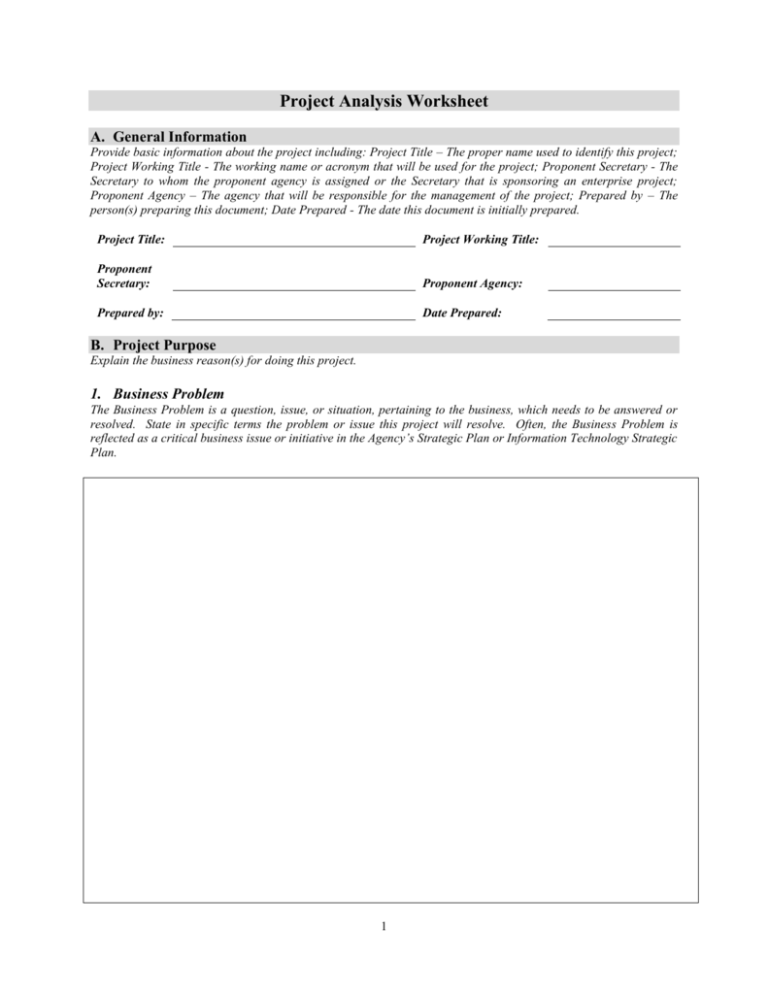
Project Analysis Worksheet A. General Information Provide basic information about the project including: Project Title – The proper name used to identify this project; Project Working Title - The working name or acronym that will be used for the project; Proponent Secretary - The Secretary to whom the proponent agency is assigned or the Secretary that is sponsoring an enterprise project; Proponent Agency – The agency that will be responsible for the management of the project; Prepared by – The person(s) preparing this document; Date Prepared - The date this document is initially prepared. Project Title: Project Working Title: Proponent Secretary: Proponent Agency: Prepared by: Date Prepared: B. Project Purpose Explain the business reason(s) for doing this project. 1. Business Problem The Business Problem is a question, issue, or situation, pertaining to the business, which needs to be answered or resolved. State in specific terms the problem or issue this project will resolve. Often, the Business Problem is reflected as a critical business issue or initiative in the Agency’s Strategic Plan or Information Technology Strategic Plan. 1 2. Project Business Objectives Define the specific Business Objectives of the project that correlate to the strategic initiatives or issues identified in the Commonwealth or Agency Strategic Plan. Every Business Objective must relate to at least one strategic initiative or issue and every initiative or issue cited must relate to at least one project Business Objective. Commonwealth or Agency Strategic Plan – Critical Issues Project Business Objectives 3. Core Business Activity Impacted Core Business Activities are agency defined cross-functional processes that produce the agency's primary products and services, or support their production. List the Core Business Activities impacted by the project and identify the impact. Agency Core Business Activity Impact on Core Business Activity 4. Constraints Constraints are items that by their nature restrict choice. Identify constraints that will influence the selection of a solution to resolve the business problem. Constraints can include but are not limited to: time, funding, personnel, facilities, and management limitations. 2 C. Preliminary Project Description Provide a preliminary description of the project approach, the customer(s) served, and expected benefits. The approach is the overall strategy for solving the business problem. The Preliminary Project Description is derived from the Project Description Statement and Section B, Project Purpose. (This description establishes the framework for identifying potential solutions.) 3 D. Solution(s) Analysis – Part I Describe each potentially viable solution, and evaluate the solution against the decision criteria described below in D.1 thru D.2.e. Duplicate the Evaluation Process (D.1 thru D.2.e) for each solution being considered. 1. Description of Solution Provide an identifier and a brief title of the potential solution. The description should include enough detail to provide a clear understanding of the solution and should differentiate it from the other potential solutions. Also, describe how the solution will resolve the Business Problem defined in Section B of this document. Solution Identifier Short Solution Title Solution Description and Detail 2. Decision Criteria The following Decision Criteria are recommended for evaluation of each potential solution. All potential solutions must be evaluated against the same set of Decision Criteria. Additional Decision Criteria may be used, if needed. a) Business Process Impact Describe how the potential solution will impact current Business Processes and the degree of organizational change and stakeholder resistance anticipated. 4 b) Technical Feasibility Describe any special technical considerations that would be required to implement the potential solution, such as technical experience required for project team members. Also, describe the level of technical complexity of the solution. c) Maturity of Solution Describe the level of technical maturity for the potential solution. The description should address questions such as “Is the potential solution technically proven or a recent innovation? Has the technology solution being proposed fully matured? Is it nearing obsolescence? Are services and expertise required to support the potential technical solution readily available? 5 d) Resource Estimate Estimate all the resources required to implement the solution. Resources include funding, personnel, facilities, customer support, equipment, and any other resources needed to implement the solution. Resource Requirement(s) Funding Project Team Customer Support Facilities Equipment Software Tools Other (Be specific) e) Constraints Impact Describe how the solution fits within the constraints identified in Section B. Specifically address any time or schedule constraints. Based on decision criteria 2.a-2.e, is the potential solution a viable solution? If yes, continue to Section E (Solution(s) Analysis – Part II). If no, discard solution. 6 ____YES _____NO E. Solution(s) Analysis – Part II Solution has been proven viable. Perform a Cost Benefit Analysis for the solution and calculate the Return on Investment. Provide a summary of the results below. A Cost Benefit Analysis and Return on Investment must be performed for each viable solution. Duplicate Solution(s) Analysis - Part II (Section E) for each solution being considered. Solution Identifier Short Solution Title 1. Cost Benefit Analysis Summary Summarize the results of the Cost Benefit Analysis for this solution. See Project Initiation (Section 2) of the Commonwealth Project Management Guideline for information on how to perform a Cost Benefit Analysis. 2. Return on Investment (ROI) Summary Summarize the estimated return achieved as a result of the investment made and explain the ROI method used. There are several ways to calculate ROI. Any method is acceptable but the same method must be used for each solution analyzed. See Project Initiation (Section 2) of the Commonwealth Project Management Guideline for instructions on Return on Investment Calculations. 7 F. Comparison of Solutions Based on the analysis performed, rate how each solution measured up against each decision criterion. A recommended Rating Scale is: 1 = Very Poor, 2 = Poor, 3 = Fair, 4 = Good, 5 = Very Good. Compare the rating results to determine which solution to recommend. Enter in the Solution Identifier in Boxes that are shaded. Decision Criteria Solutions Business Process Impact Technical Feasibility Maturity of Solution Resources Required Constraints Impact Cost Benefit Analysis Return on Investment Other Total Score G. Preliminary Recommendation Describe the Recommended Solution and provide a summary of the rationale for selecting it. 1. Recommended Solution Specify the Recommended Solution selected as a result of the analysis. Use the description previously provided in Section D of this document. Solution Identifier Short Solution Title 2. Recommended Solution Justification Explain why the Recommended Solution was chosen over the other solutions considered. 8 H. Decision Document the project sponsor’s or designated agency manager’s decision regarding the Recommended Solution. If the Recommended Solution is accepted, a Project Proposal is developed. __ Accepted __ Rejected __ On Hold Approved By: Name: _______________________________________ Title: ________________________________________ Date: ________________________________________ 9 __ Requesting More Information
